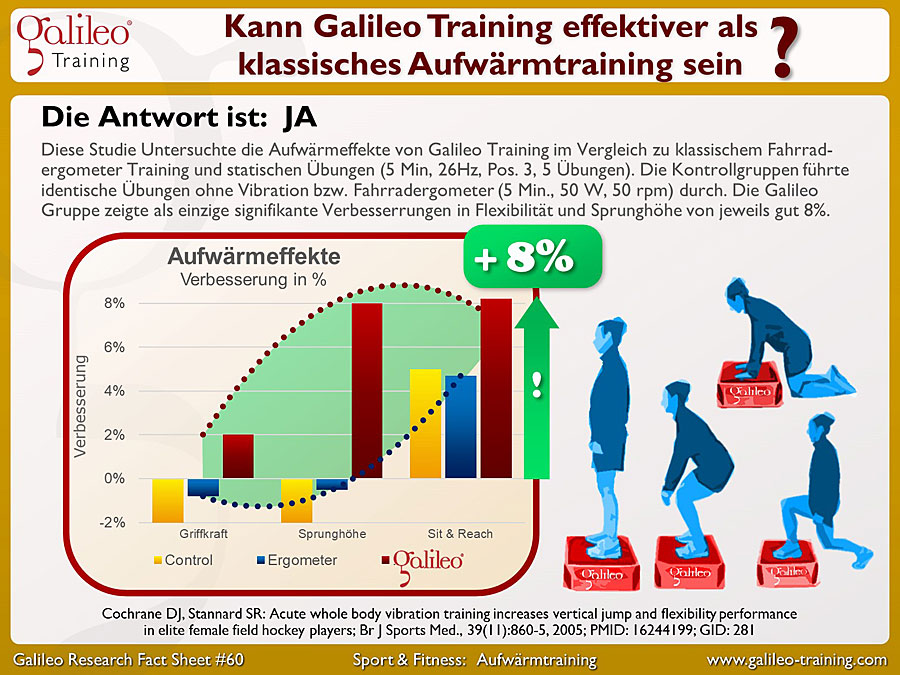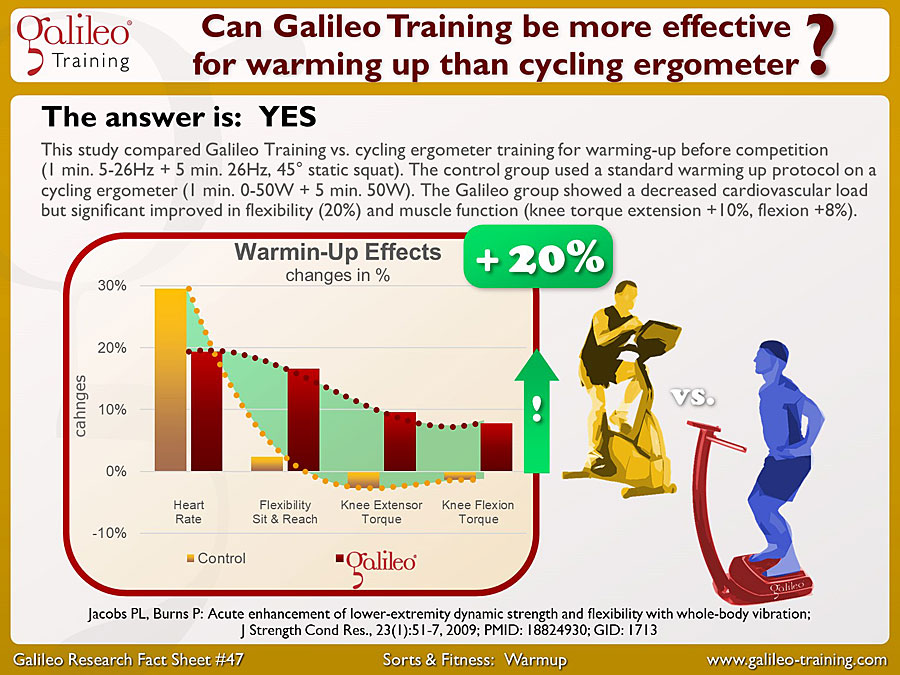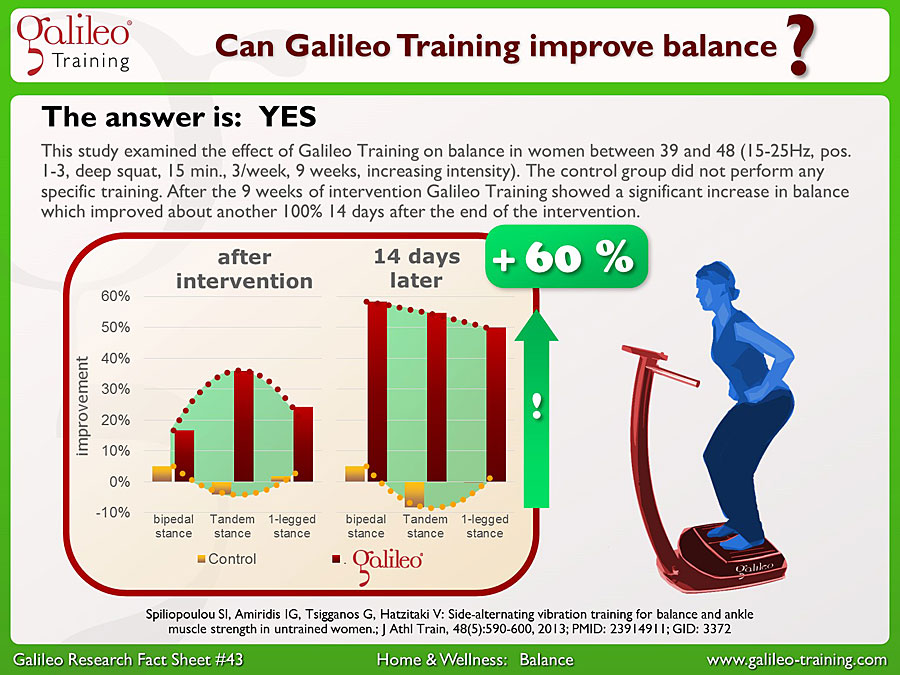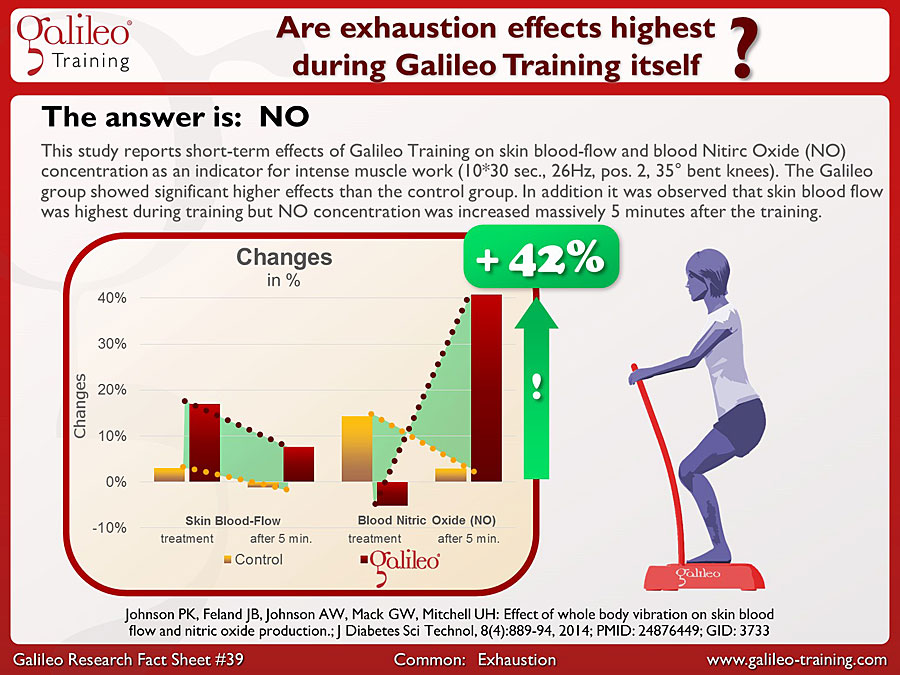This study examined the warm up effects of Galileo Training in comparison to traditional warm up (cycling ergometer) and static exercises (5 min., 26Hz, pos. 3, 5 exercises). The control groups used identical exercises without vibration and traditional cycling ergometer (5 min. 50 W, 50 rpm). Only the Galileo Groups showed significant improvements for jumping height and flexibility (sit & reach) of more than 8%...
Galileo Research Facts No. 59: Are high frequencies for stretching more effective and lasting than mid frequencies?
This study examined for Galileo Training the effects of different frequencies on increase of flexibility (6 min. pos. 3, 20° bent knees, 15, 20, 30Hz). The control group performed the same exercises without vibration. ´The effects of Galileo Training on flexibility where significantly higher at mid frequencies (15 & 20Hz) compared do high frequencies (30 Hz). The differences where even higher 15 Minutes after the exercise...
Galileo Research Facts No. 54: Can Galileo Training using deep squats effectively reduce fall risk and improve balance in elderly?
This study reports the effect of 6 months of Galileo Training with and without deep squatting on balance, gait and fall risk in 68 – 79 year old (20Hz, 4 min., 2/week, 6 months). Both groups received Galileo Training, group 1 using static squats at 45° knee angle, group 2 used slow dynamic squats between 45° and 60°. Group 2 improved function in average by 30% more than group 1 with improvements in Balance of 40%...
Galileo Research Facts No. 50: Can 5×1 minutes Galileo dumbbell Training increase muscle power in athletes?
This study investigated the immediate effects of Galileo Mano Training (vibration dumbbell) on muscle power and muscle activation (EMG) in elite boxers (5x 1 min., 30Hz, 145° bent arms). One arm was trained the other was used as internal control. The side trained with Galileo could improve muscle power when lifting 5% of body mass by 13%. During Galileo Training muscle activation was increased by 110%...
Galileo Research Facts No. 47: Can Galileo Training be more effective for warming up than cycling ergometer?
This study compared Galileo Training vs. cycling ergometer training for warming-up before competition (1 min. 5-26Hz + 5 min. 26Hz, 45° static squat). The control group used a standard warming up protocol on a cycling ergometer (1 min. 0-50W + 5 min. 50W). The Galileo group showed a decreased cardiovascular load but significant improved in flexibility (20%) and muscle function (knee torque extension +10%, flexion +8%)...
Galileo Research Facts No. 46: Can Galileo Training reduce Creatin Kinase after extensive endurance Training?
This study tested the effect of Galileo Training on Creatine Kinase (CK) concentration after exhaustive endurance training. Both groups trained treadmill + 4x400 (HIIT) + 3km Time-Trial. The Galileo Group trained at 12Hz (5x60 sec. slight squats, 5x30 sec. sitting with feet on Galileo). 24 h after the intensive endurance training Creatine Kinase levels where reduced by 20% in the Galileo group compared to control...
Galileo Research Facts No. 45: Can Galileo Training in artificial weightlessness prevent bone loss?
The first Galileo Space-Study examined its effects on muscle and bone mass in simulated weightlessness (55 days bedrest, 10 min., 5 days/week 12-26Hz). The control group did not have any training. While the control group showed massive loss of bone mass (over 15%) the Galileo Group could almost completely compensate this effect (in strict bed-rest over 55 days!) and even showed higher bone mass (+4%) after 1 year follow-up...
Galileo Research Facts No. 44: Can Galileo Training in artificial weightlessness prevent loss of muscle and muscle function?
The first Galileo Space-Study examined its effects on muscle and bone in simulated weightlessness (55 days bedrest, 10 min., 5 days/week 12-26Hz). The control group did not have any training. While the control group showed massive loss in muscle cross-section, the Galileo groups hardly lost any muscle and could even improve muscle function (max torque) by 12% (in strict bed-rest over 55 days without any other exercise!)...
Galileo Research Facts No. 43: Can Galileo Training improve balance?
This study examined the effect of Galileo Training on balance in women between 39 and 48 (15-25Hz, pos. 1-3, deep squat, 15 min., 3/week, 9 weeks, increasing intensity). The control group did not perform any specific training. After the 9 weeks of intervention Galileo Training showed a significant increase in balance which improved about another 100% 14 days after the end of the intervention...
Galileo Research Facts No. 39: Are exhaustion effects highest during Galileo Training itself?
This study reports short-term effects of Galileo Training on skin blood-flow and blood Nitirc Oxide (NO) concentration as an indicator for intense muscle work (10*30 sec., 26Hz, pos. 2, 35° bent knees). The Galileo group showed significant higher effects than the control group. In addition it was observed that skin blood flow was highest during training but NO concentration was increased massively 5 minutes after the training...









